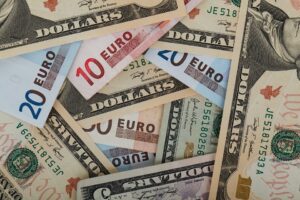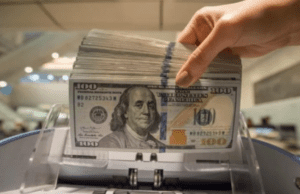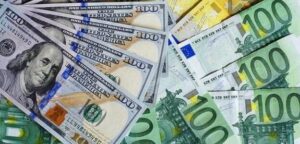
The US dollar is depreciating against the euro, yen and pound sterling in trading on Wednesday, the market awaits the results of a two-day meeting of the Federal Reserve System (Fed).
Traders have no doubt that the rate will be increased by 75 bp following the November meeting. for the fourth time in a row, and their focus is on statements by Fed Chairman Jerome Powell on the further pace of policy tightening.
Signals of persistent inflationary pressures require the US Central Bank to continue to raise rates, but some of its leaders have already made it clear that they consider it necessary to slow down the rate of increase and assess the economic consequences of earlier measures, The Wall Street Journal notes.
Many economists warn of the risks of the Fed tightening too much, which could trigger a severe economic downturn.
“The Fed will have to think about policy adjustments at the November meeting. They are trying to ‘cool’ the economy, not lead it to a deep freeze,” said KPMG chief economist Diane Swank, quoted by the WSJ.
Experts polled by Bloomberg expect the Fed to slow down the rate hike in December to 50 bp, after which it will raise it two more times by 25 bp. at the beginning of 2023.
The ICE-calculated index, which shows the dynamics of the dollar against six currencies (the euro, the Swiss franc, the yen, the Canadian dollar, the pound sterling and the Swedish krona), is losing 0.2% on Wednesday, the broader WSJ Dollar – 0.24%.
The euro/dollar pair is trading at $0.9893 at 9:00 AM, compared to $0.9874 at the market close on Tuesday.
The US dollar against the yen fell to 147.52 yen against 148.24 yen in the previous session.
The pound rose to $1.1510 from $1.1482 on Tuesday.
The Bank of England is also holding a meeting this week, its results will be made public on 3 November. Experts expect the British Central Bank to raise the base rate by 75 bp. – until 3%. The Bank of England did not raise the rate by more than 50 bp. since 1989, notes FT.

The US dollar strengthens against the euro, yen and pound sterling in trading on Monday.
The market is waiting for the meeting of the Federal Reserve System (Fed), which will be held on November 1-2. Traders are confident that the US Central Bank will raise the base interest rate by 75 basis points (bp) following the results of the fourth meeting in a row. As a result, the rate will reach the level of 3.75-4% – the maximum since December 2007.
Traders will be closely watching Fed Chairman Jerome Powell’s statements to see if the US central bank intends to slow down the pace of policy tightening from December, writes the Financial Times newspaper. The global economy is weakening, and experts are already seeing signs that the peak of inflation in the United States has passed. In this regard, investors are increasingly expressing fears that the Fed may overdo it with raising rates and provoke an excessive recession in the economy.
The ICE-calculated index, which shows the dynamics of the dollar against six currencies (the euro, the Swiss franc, the yen, the Canadian dollar, the pound sterling and the Swedish krona), adds 0.08% on Monday, the broader WSJ Dollar – 0.19%.
The euro/dollar pair is trading at $0.9946 as of 8:55 am KSK, compared to $0.9966 at market close on Friday.
The US dollar against the yen rose to 147.92 yen against 147.48 yen in the previous session.
The pound dropped to $1.1592 from $1.1617 on Friday.
The Bank of England is also holding a meeting this week, its results will be made public on 3 November. Experts expect the British Central Bank to raise the base rate by 75 bp. – until 3%. The Bank of England did not raise the rate by more than 50 bp. since 1989, notes FT.
The dollar against the yuan edged up to 7.2698 yuan from 7.2525 yuan at market close on Friday amid weak economic data from China.
The Purchasing Managers’ Index (PMI) for China’s manufacturing industry fell to its lowest level since July of 49.2 in October from 50.1 a month earlier, according to data from the National Bureau of Statistics of the People’s Republic of China (GSO). An index value below 50 points indicates a decline in activity in the sector.
PMI services in China in October fell to 48.7 points, dropping below 50 points for the first time since May.

The dollar exchange rate on Thursday morning changes slightly against the euro and the pound, while the US currency is sharply declining against the yen.
The euro/dollar pair is trading at $1.0076 by 8:57 sq.m. against $1.0086 at the close of the session on Wednesday, the euro is losing about 0.1%.
The pound is trading at $1.1625 compared to $1.1628 at the close of the previous session.
The dollar fell 0.8% against the yen to 145.27 yen compared to 146.39 yen the day before. Earlier this month, the yen fell to its lowest level since 1990.
The ICE-calculated index, which shows the performance of the US dollar against six currencies (the euro, the Swiss franc, the yen, the Canadian dollar, the pound sterling and the Swedish krona), is down about 0.1%. Over the past two sessions, the indicator fell by 2% and dropped to a month low.
The main reason for the fall of the dollar this week was the expectation that the Federal Reserve may slow down the pace of raising the key rate as inflation eases and problems in the US economy, writes Trading Economics.
Analysts, on average, expect the Fed to raise rates by 75 basis points in November and expect a 50 bp hike in December.
Also, market participants are waiting for the results of the meetings of the European Central Bank and the Bank of Japan, which will end this week.
The ECB is expected to raise key interest rates again on Thursday by 75 bp. The European Central Bank is constrained from refusing to raise interest rates in the near term as consumer price growth in the euro area is likely to have not peaked yet, BlueBay Asset Management chief investment officer Mark Dowding said in an interview with Dow Jones.
Meanwhile, the Bank of Japan on Friday, most likely, will not change the main parameters of its monetary policy.

The US dollar is weakly strengthening against the euro at auction on Monday, depreciating against the pound sterling.
The yen against the dollar, which jumped at the beginning of the session, again moved to the decline.
The ICE-calculated index showing the dynamics of the dollar against six currencies (the euro, the Swiss franc, the yen, the Canadian dollar, the pound sterling and the Swedish krona) adds less than 0.1%, the broader WSJ Dollar Index – 0.25%.
The euro/dollar pair is trading at $0.9855 as of 9:15 p.m. compared to $0.9864 at the market close on Friday
The pound sterling has risen in price by this time to $1.1375 in comparison with $1.1304 following the results of the previous auctions. The pound strengthens after the refusal of former British Prime Minister Boris Johnson to fight for the post of leader of the Conservative Party and, accordingly, the head of the British government.
This gives ex-Finance Minister Rishi Sunak a good chance of winning, the Financial Times notes.
The dollar/yen pair was trading at 148.93 yen as of 9:15 a.m. versus 147.68 yen at market close on Friday. At the beginning of the session, the dollar fell to 145.53 yen, but then again turned to growth.
On Friday, the US currency fell 0.72% against the yen, which the Nikkei newspaper attributed to the intervention of the Japanese authorities in the foreign exchange market.
Japan’s Finance Minister Shun’ichi Suzuki said on Monday that the Japanese government would take the necessary measures to prevent “excessive exchange rate fluctuations.”
He declined to say whether there were interventions on Friday and Monday.
The dollar against the yen on Friday rose to 151.94 yen – the highest since July 1990.
The dollar against the yuan edged up to 7.2535 yuan from 7.2438 yuan despite stronger than expected Chinese GDP data.
China’s GDP in the third quarter increased by 3.9% in annual terms after rising by 0.4% in April-June. The consensus forecast of experts polled by Trading Economics called for growth of 3.4%.

The US dollar is getting cheaper against the euro and the pound sterling at the auctions on Monday, it is stable against the yen.
The ICE-calculated index, which shows the dynamics of the dollar against six currencies (the euro, the Swiss franc, the yen, the Canadian dollar, the pound sterling and the Swedish krona), is losing 0.29%, the broader WSJ Dollar Index – 0.27%.
The euro/dollar is trading at $0.9750 compared to $0.9722 at the market close on Friday.
The rate of the American currency against the yen is 148.72 yen against 148.75 yen following the results of the previous session.
The pound rose to $1.1272 from $1.1183. On Friday, British Prime Minister Liz Truss fired Chancellor of the Exchequer Quasi Kwarteng, appointing Jeremy Hunt to the post.
According to the Financial Times, several British Conservative MPs and prominent figures from the City of London are calling for Truss herself to step down as prime minister after controversial economic decisions that undermined her credibility.
Britain’s new finance minister told the BBC last Sunday, speaking of the possibility of winding down any of the government’s recent stimulus measures, that “nothing is out of the question.”
Later on Monday, Hunt intends to make a statement regarding the country’s medium-term budget.
The dollar rose against the yuan during trading to 7.1996 yuan from 7.1910 yuan at market close on Friday. Chinese President Xi Jinping, speaking at the 20th Congress of the Chinese Communist Party (CCP), which opened on Sunday, signaled that the country’s authorities would continue their tough policy to contain the spread of COVID-19, which has already seriously weakened the country’s economy this year.

US dollar is stable against the euro, strengthening against the yen and the pound sterling on Friday.
The ICE-calculated index, which shows the dynamics of the dollar against six currencies (the euro, the Swiss franc, the yen, the Canadian dollar, the pound sterling and the Swedish krona), adds 0.03% during trading, the broader WSJ Dollar Index loses 0.02%.
The data of the US Department of Labor published the day before showed a weaker-than-expected slowdown in inflation. The CPI rose in September by 8.2% against the same month last year – the lowest rate in seven months. Experts polled by Trading Economics predicted, on average, a slowdown in inflation to 8.1% from 8.3% in August.
Meanwhile, core inflation, excluding the cost of food and energy (Core CPI) accelerated in September to the highest since August 1982 6.6% in annual terms from 6.3% a month earlier.
Published statistical data have strengthened investors in the opinion that the Federal Reserve System (Fed) will continue the rapid tightening of monetary policy. Now traders are waiting for a sharp rise in the rate of the US Central Bank at each of the two remaining meetings of this year, Bloomberg notes.
The euro/dollar pair is trading at $0.9781 compared to $0.9780 at the close of the previous session.
The US currency against the yen is 147.45 yen against 147.22 yen at the close of the market on Thursday.
The pound fell to $1.1322 from $1.1331 the day before.
British Treasury Secretary Kwazi Kwarteng left Washington, where he was meeting with representatives of the International Monetary Fund (IMF), a day earlier than planned. Experts believe that he may abandon part of the tax cuts he announced earlier in order to prevent an economic crisis in the country, the Financial Times writes.
The newspaper’s sources note that the IMF and finance ministers of several other countries recommended that he quickly abandon plans for tax cuts in order to avoid financial problems in the economy.